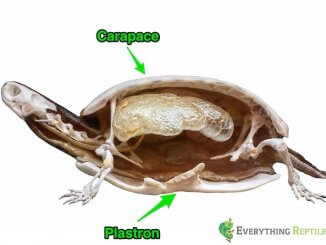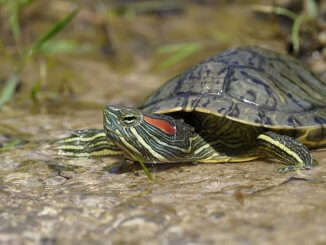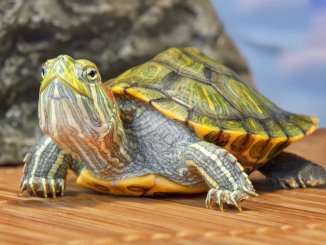Red-eared sliders are a beautiful species of turtle. They are named for the bright red spot behind each of their eyes.
Like many turtle species, male and female sliders are very similar in appearance. It is not always easy to tell the difference between male or female turtles right away.
However, there are several tips and subtle differences that you can use to determine if your red-eared slider is a male or female.
If you are planning to breed your turtle or want to pick out a good name you will want to find out the sex of your turtle. Want to know how? Continue reading for five foolproof ways…
Red-Eared Slider Male Or Female
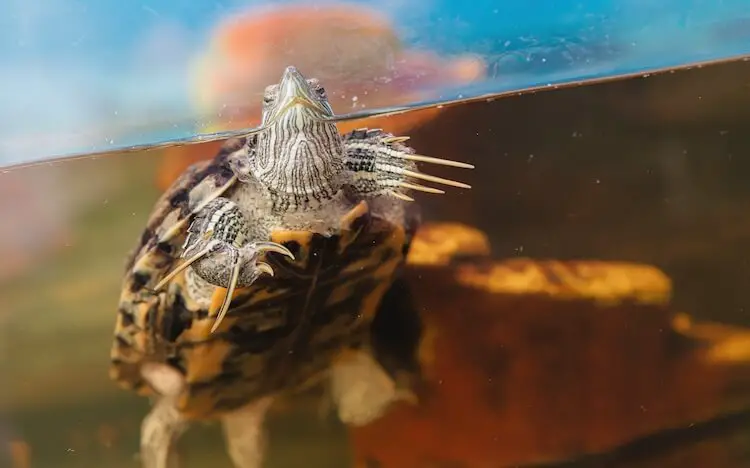
Male vs female red-eared sliders look similar at first glance.
Once you start to look closer, though, there are five key ways that you can use to determine the gender of your turtle. These methods work best when sexing adult sliders, but some can also be used on babies and hatchlings.
1. Claw Length
Perhaps the easiest way to tell male and female sliders apart is the length of their front claws.
Male sliders have long front claws, averaging 1.52cm. They use their claws when mating females during the breeding season. Male claws are almost 3x the length of the claws on their back feet. On average, their front claws are 1.52cm vs 0.5cm for the back claws.
The claws of females are stubby and much shorter, averaging just 0.8cm. Their claws are the same length as their back claws.
To prepare for breeding, the claws of males grow quickly at the beginning of sexual maturity (2 to 3 years old). Females’ claws grow slowly throughout their whole lives, they never get as long as males’ claws, even in old age.
To sex your turtle, take a look at its front claws.
By the time a male is three, he will be well on the way to having the characteristic long nails. Females are not sexually mature until they reach five, but even then, their claws are significantly shorter than males’.
Sometimes, males that were either raised in small tanks or not given the proper diet can have underdeveloped claws. However, if you take good care of your turtle and notice it has long front claws, then it is a male.
Keep in mind, however, that this technique only works for red-eared sliders older than three.
Sliders under two years will also have short nails regardless of their sex because males’ claws have not yet developed.
2. Shell Size
Red-eared sliders are sexually dimorphic. This means that full-grown males and females are noticeably different in physical attributes, particularly size, in this case. Female sliders are larger than males.
Female red-eared sliders can weigh up to 7 pounds with an average shell length of 10 inches, though lengths of 13 inches and weighs of 7.5 pounds have been recorded.
On the other hand, males more commonly weigh around 4 pound and have an average shell length of just 7 inches.
| Male | Female | |
|---|---|---|
| Shell Length | 7 inches | 10 inches |
| Weight | 4 pounds | 7 pounds |
This method works best if you have more than one turtle.
A size comparison will give you a more accurate idea of a turtle’s gender than simply looking at average sizes.
Some male sliders may be above the average male size and some females may be below the average female size, so determining the sex of a turtle from averages alone may not be correct. Instead, compare the sizes of two or more turtles. If one is quite a bit bigger than the others, it is more likely to be a female.
When comparing turtles, make sure they are the same age. Comparing a 2-year-old and 6-year-old turtle will not work.
Red-eared sliders are fully grown when they reach six years of age.
Make sure your turtle is at its adult size before you look at its weight and shell length.
3. Shell Shape
Male and female sliders have differently shaped plastrons (i.e. the bottom or “stomach-side” of the shell). This is true for all turtle shells.
In females, the bottom of their shell is smooth, flat, or slightly bowed out (i.e. convex).
Male red-eared sliders have a shell that is bowed in towards the spine (i.e. concave). This shape makes a slight depression or bowl shape in the shell and helps with mounting females during breeding.
To check the shell, lift up your turtle carefully with two hands. Make sure not to flip or tilt it. Feel the bottom (underside) of the shell with your hand. If the plastron is flat or slightly curved outwards, the slider is a female. If it curves inwards, the slider is a male.
The shell shape starts to develop in young turtles between 1 to 2 years old.
Hatchling turtles are too small to accurately sex this way, but for slightly older species that measure four inches long, shell shape can help you sex a juvenile.
4. Tail Shape
Looking at a red-eared slider’s tail is another way to determine its gender.
Males have long, thick tails that stick out quite a bit from their shell.
Females have shorter, thinner tails that are less noticeable.
When looking at male vs female red-eared turtles, the slider with the thicker tail is likely to be a male.
Males have thick tails because their reproductive organs are housed near the end of the body. Females’ reproductive organs are farther up in their bodies to make it easier to lay eggs, and so they do not need to have a thick tail.
In addition to tail shape, the position of the cloaca (i.e. reproductive/waste opening) of a turtle can tell you whether the slider is male or female.
The cloaca of a male turtle is positioned farther down the tail, which helps him mate with the female. A female’s cloaca is just below the edge of the shell.
A cloaca that is halfway down the tail is characteristic of a male slider.
5. Slider Color
Another difference between male and female red-eared sliders is how much their appearance changes over their lives. Males and females hatch looking nearly identical, but males change color as they age.
When male red-eared sliders age their color tends to darken. While male and female sliders have the same skin and shell patterns, males can darken over time.
This natural aging happens to both sexes, though males especially develop more melanin as they move into adulthood. Males often have higher levels of the melanin pigment in their skin than females, which causes them to darken over time.
You will notice an older turtle’s skin and shell becoming much darker overall. Some older males may appear completely black, without the yellow and red streaks seen in younger sliders. This is much rarer in females, who tend to keep their bright colors.
If this color change happens over the course of several months, it is a sign that your slider is a male. While not every male will lose his stripes, the likelihood of this happening is much higher in males than females.
Some females grow darker with age, but generally females keep their yellow and red markings.
Remember, this sexing method only works for adult turtles.
It is not 100% foolproof, but it can provide a quick clue about your turtle’s gender.
Male vs Female Red-Eared Slider Differences
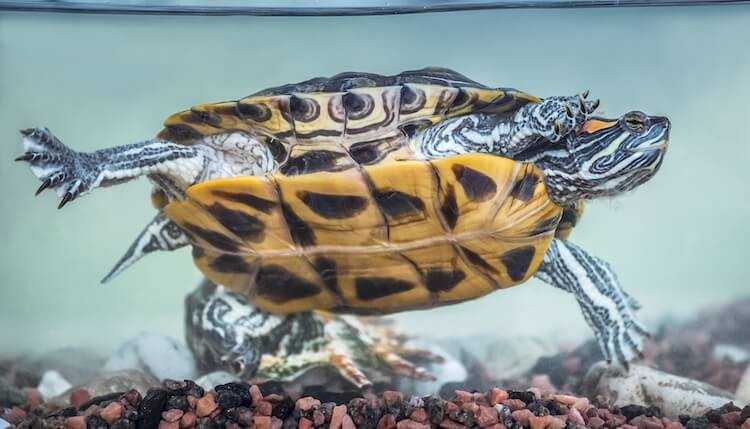
The biggest differences between male and female sliders are related to the size of their tails, nails and shells.
Male sliders grow long claws, a concave plastron, and a thicker, longer tail than females. Their colors are also more likely to fade and darken once they reach five years old.
Females are significantly bigger in size than males, but do not undergo the same color changes.
| Males | Females | |
|---|---|---|
| Claw Length | Long front claws averaging 1.52cm | Short front claws averaging 0.8cm |
| Size | 7 inches long | 11 to 13 inches long |
| Tail | Long and thick | Short and thin |
| Shell Shape | Curved inwards | No curve |
| Color | Darker, may lose stripes | Will keep yellow stripes and red “ear” marking |
Male and female turtles are also different in several other ways, especially in their behavior.
In most cases, males are more territorial than females and will chase off other males who get too close, particularly if they are in an area with limited food.
Aggressive turtles will hiss, bite, and hit each other with their shells until the weaker individual backs down and moves to a new location. Pet male sliders are more likely to act aggressively towards their tankmates, especially during feeding time.
Females are overall more tolerant of living in groups than males.
Because of these behaviors it is always best to keep male red-eared sliders in their own tank.
Male and female red-eared sliders are also different in their breeding behavior.
Females are not ready to breed until they are several years older than males because they need to be larger and have more energy for laying eggs. Once she reaches five, a female may show signs that she is ready to lay eggs.
A female who is gravid will become more active, restless, and may stop eating until she finds a good place to lay. It is important to provide your female slider with a nesting box even if you do not have any male turtles, as she will likely have unfertilized eggs at some point in her life.
Though male and female sliders eat the same foods, their diet can change if they are breeding.
When a female is developing eggs, she may start to show a preference for foods high in calcium such as beet greens, bok choy, papaya, or whole fish. Eating more calcium helps build strong eggshells.
Male sliders will not show nesting behavior and do not need any special food.
What Age Can You Tell The Difference?
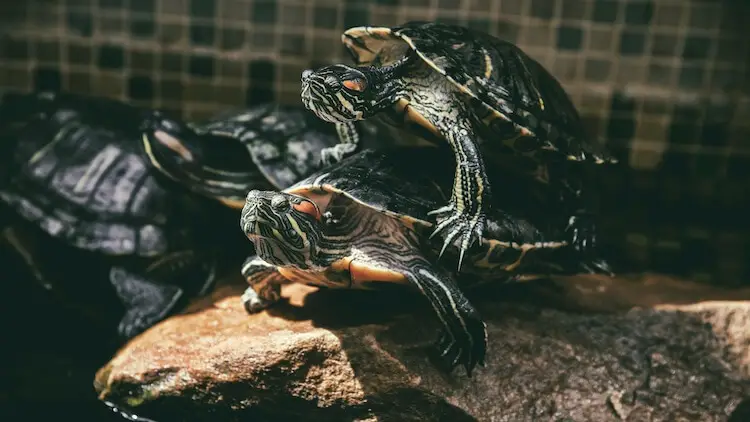
Hatchling red-eared sliders are the size of a quarter, which makes identifying any differences between males and females a difficult task.
Luckily, juvenile turtles grow very quickly and reach two inches within their first year. By the time they are two years old, some differences between males and females start to become apparent:
- Males will start to develop their long front claws and their tails will become noticeably thicker.
- Females may start to grow larger than males at this point, though not always.
By the time a slider turtle reaches three years old, males will be easy to spot.
If housed in a good environment, males will have long front claws and a slight inward curve to the bottom of their shell. You should also be able to see the position of their cloaca, which is located halfway down the tail in males.
Female red-eared sliders don’t mature until they are 5 years old and seven inches long. At this age, you should be able to tell with a good amount of certainty whether your slider is a female or male. Females will be bigger and have shorter claws, a thinner tail, and a smooth plastron.
Unless you have several sliders together and want to prevent breeding, there is no problem waiting until your slider is an adult before determining its gender.
How To Sex A Baby Red-Eared Slider
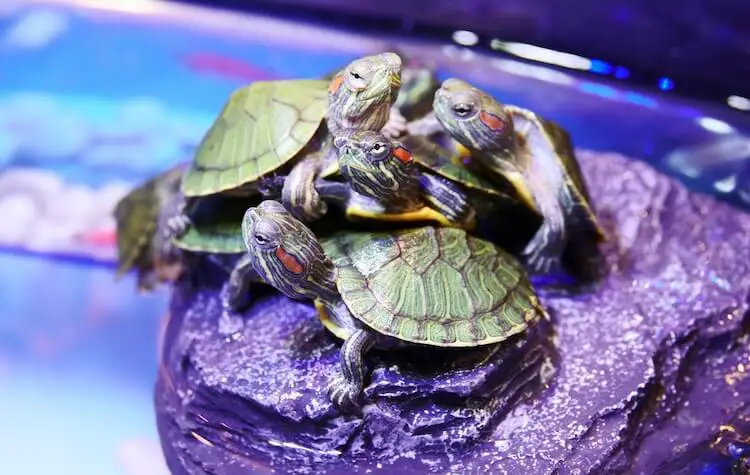
It can be tricky to tell the gender of a very young slider.
Newly hatched sliders are the size of a quarter, which makes spotting any key male or female differences a tricky task! It is notoriously difficult to sex a turtle before they are two years old.
To determine the sex of a baby red-eared slider, the only way is to check the temperature the eggs were incubated at.
Sliders have temperature-dependent sex determination.
Turtles hatched from eggs incubated at different temperatures will be of different sexes.
Eggs incubated at 78.8°F (26°C) will be all males, and those incubated at 89.6°F (32°C) will be all female. Incubating eggs at temperatures between those two extremes will produce a mixture of males and females.
Cooler-incubated eggs will be 100% male and hotter-incubated eggs will be 100% female.
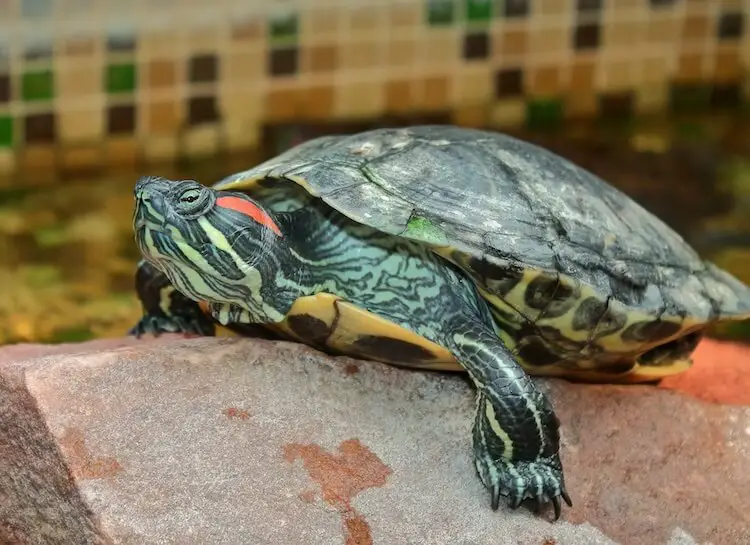
Summary
Determining the gender of a red-eared slider turtle relies on a few key signs.
Male sliders have long front claws, a dip in the bottom of their shell, and a thick tail. Females have short claws, a thin tail, a cloaca that is close to the body, and they are bigger.
Unless you know the temperature at which your slider’s egg was incubated, telling male vs female sliders apart is almost impossible for newly hatched babies. It’s much easier to wait until they reach two years old.
You can estimate the age of older turtles based on their size and color.
Both males and females will be around 4 inches long when they reach 2 years old. If your turtle stops growing and is close to 5-6 inches, it will likely be male. If it continues to grow, it is likely a female.
Has this reading helped you find your slider’s gender? Let us know how old your slider is and if you figured out its gender in the comments below!

